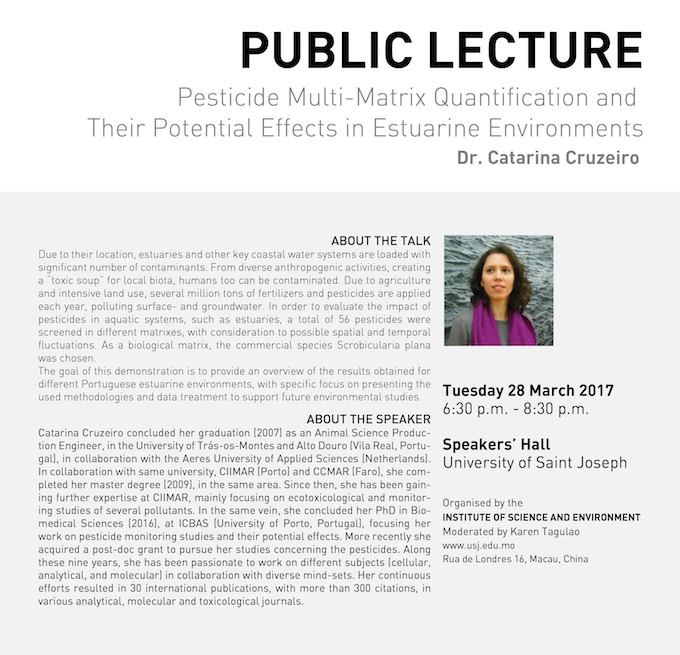Public Lecture: Pesticide Multi-Matrix Quantification and Their Potential Effects in Estuarine Environments

Public Lecture: Pesticide Multi-Matrix Quantification and Their Potential Effects in Estuarine Environments
28
Mar
Public Lecture: Pesticide Multi-Matrix Quantification and Their Potential Effects in Estuarine Environments by ISE on 28th March 2017.

About the Talk
Due to their location, estuaries and other key coastal water systems are loaded with significant number of contaminants. From diverse anthropogenic activities, creating a “toxic soup” for local biota, humans too can be contaminated. Due to agriculture and intensive land use, several million tons of fertilizers and pesticides are applied each year, polluting surface- and groundwater. In order to evaluate the impact of pesticides in aquatic systems, such as estuaries, a total of 56 pesticides were screened in different matrixes, with consideration to possible spatial and temporal fluctuations. As a biological matrix, the commercial species Scrobicularia plana was chosen.
The goal of this demonstration is to provide an overview of the results obtained for different Portuguese estuarine environments, with specific focus on presenting the used methodologies and data treatment to support future environmental studies.
About the Speaker
Catarina Cruzeiro concluded her graduation (2007) as an Animal Science Production Engineer, in the University of Trás-os-Montes and Alto Douro (Vila Real, Portugal), in collaboration with the Aeres University of Applied Sciences (Netherlands). In collaboration with same university, CIIMAR (Porto) and CCMAR (Faro), she completed her master degree (2009), in the same area. Since then, she has been gaining further expertise at CIIMAR, mainly focusing on ecotoxicological and monitoring studies of several pollutants. In the same vein, she concluded her PhD in Biomedical Sciences (2016), at ICBAS (University of Porto, Portugal), focusing her work on pesticide monitoring studies and their potential effects. More recently she acquired a post-doc grant to pursue her studies concerning the pesticides. Along these nine years, she has been passionate to work on different subjects (cellular, analytical, and molecular) in collaboration with diverse mind-sets. Her continuous efforts resulted in 30 international publications, with more than 300 citations, in various analytical, molecular and toxicological journals.









